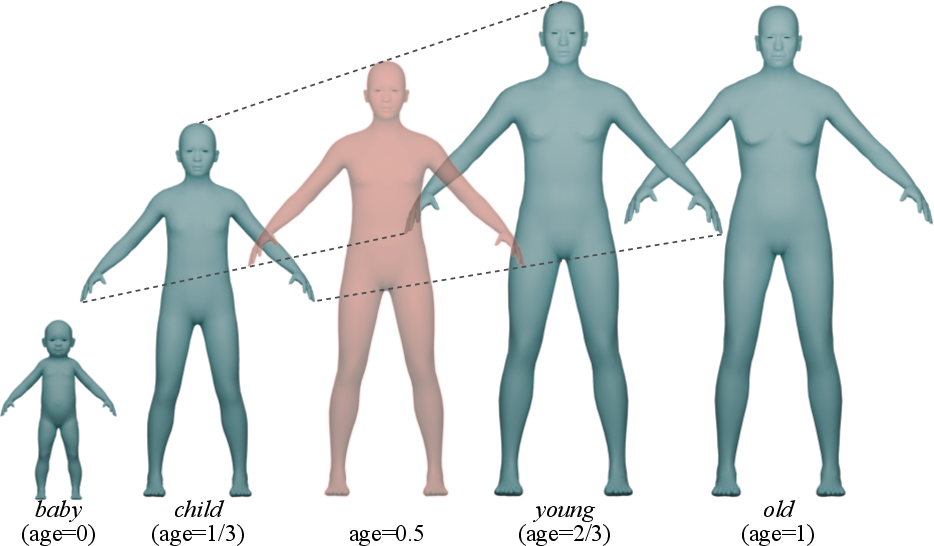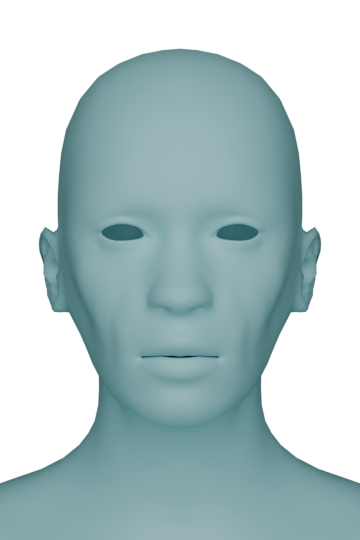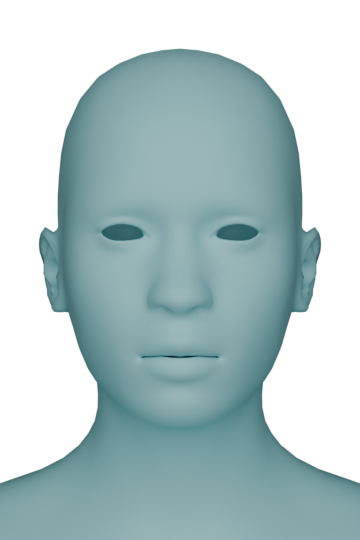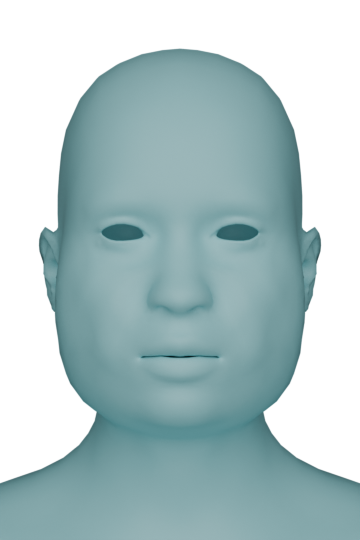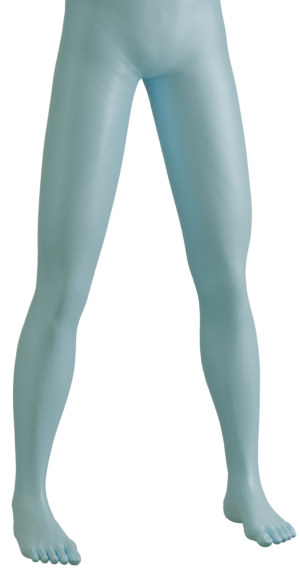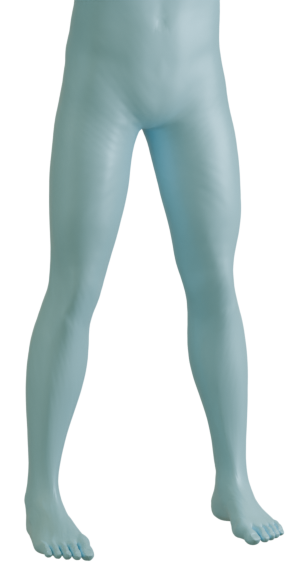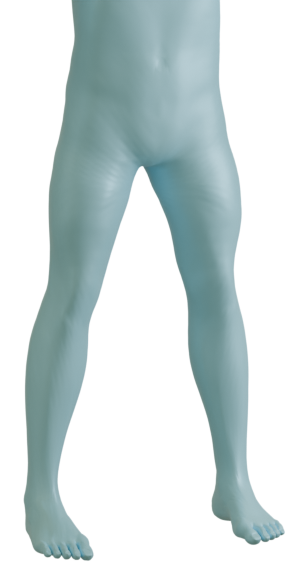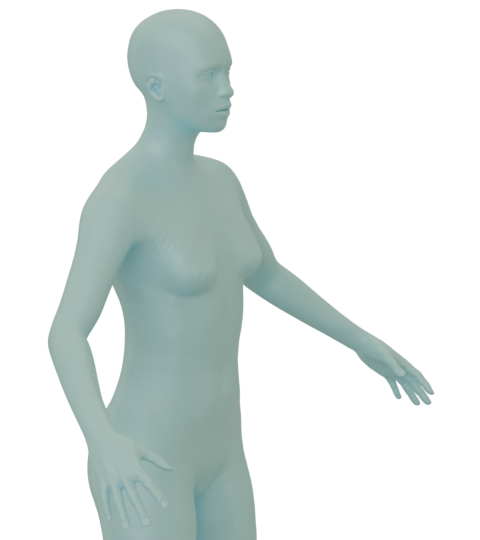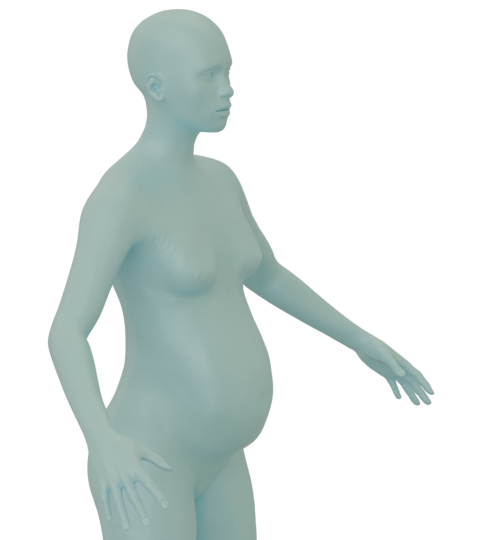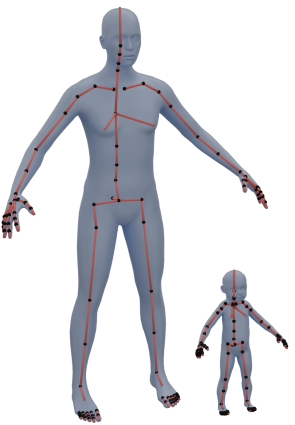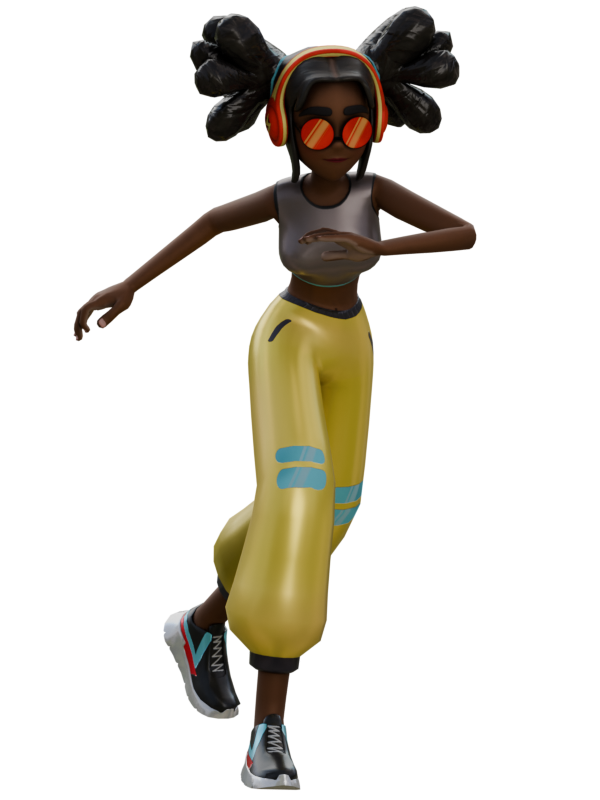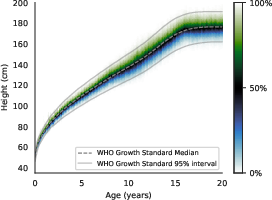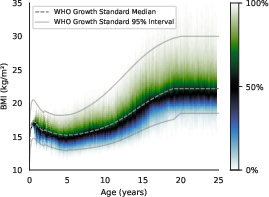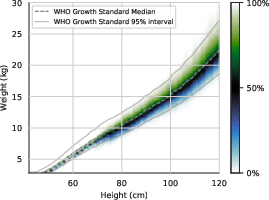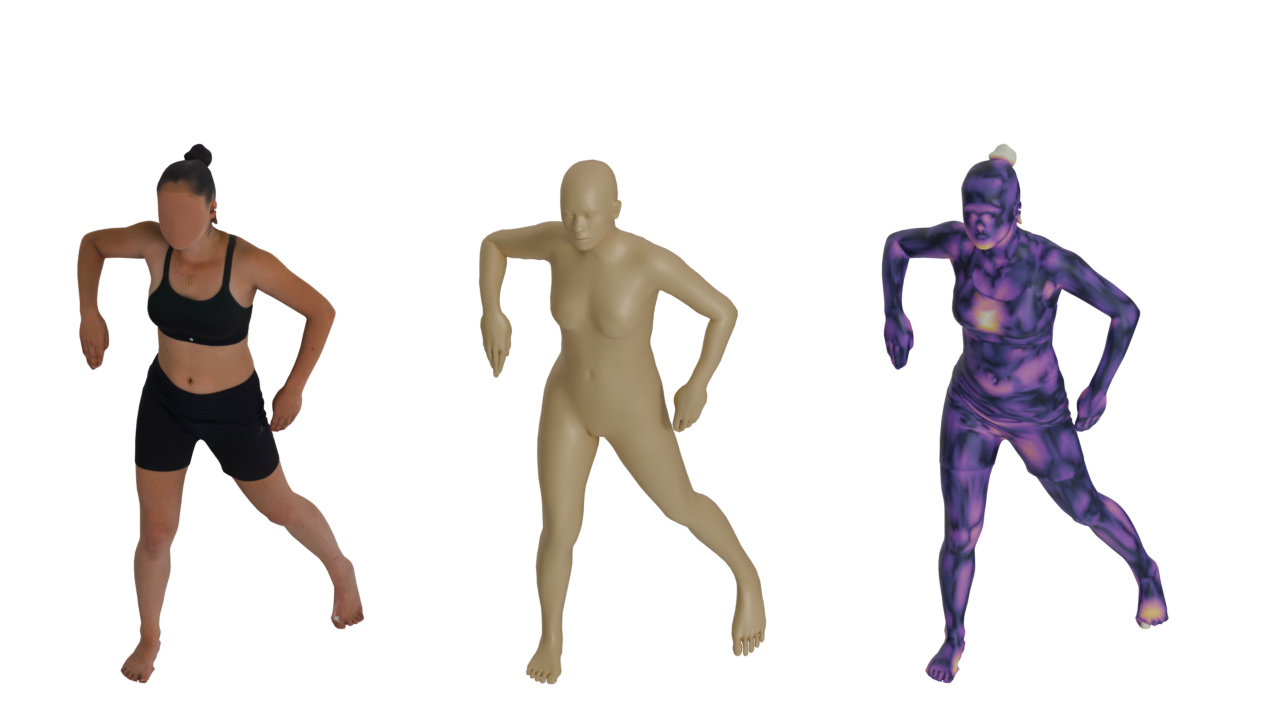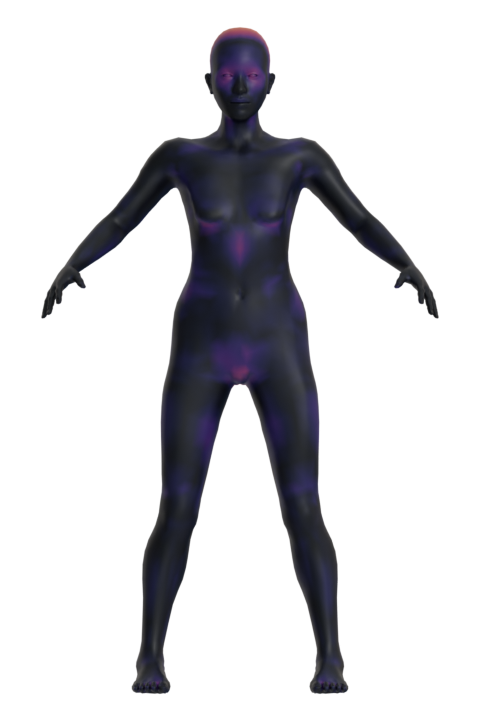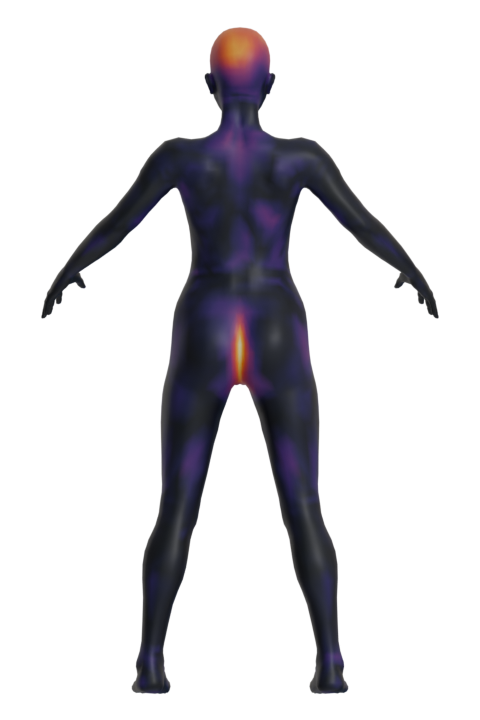Human Mesh Modeling for Anny Body (2511.03589v1)
Abstract: Parametric body models are central to many human-centric tasks, yet existing models often rely on costly 3D scans and learned shape spaces that are proprietary and demographically narrow. We introduce Anny, a simple, fully differentiable, and scan-free human body model grounded in anthropometric knowledge from the MakeHuman community. Anny defines a continuous, interpretable shape space, where phenotype parameters (e.g. gender, age, height, weight) control blendshapes spanning a wide range of human forms -- across ages (from infants to elders), body types, and proportions. Calibrated using WHO population statistics, it provides realistic and demographically grounded human shape variation within a single unified model. Thanks to its openness and semantic control, Anny serves as a versatile foundation for 3D human modeling -- supporting millimeter-accurate scan fitting, controlled synthetic data generation, and Human Mesh Recovery (HMR). We further introduce Anny-One, a collection of 800k photorealistic humans generated with Anny, showing that despite its simplicity, HMR models trained with Anny can match the performance of those trained with scan-based body models, while remaining interpretable and broadly representative. The Anny body model and its code are released under the Apache 2.0 license, making Anny an accessible foundation for human-centric 3D modeling.
Paper Prompts
Sign up for free to create and run prompts on this paper using GPT-5.
Top Community Prompts
Explain it Like I'm 14
Anny: A Simple, Open 3D Model of the Human Body
Overview: What is this paper about?
This paper introduces Anny, a new computer model for creating 3D human bodies. Unlike many popular models that learn from expensive, private 3D scans of real people, Anny is built from open, community-made knowledge about how human bodies look at different ages and sizes. It aims to represent many kinds of people—from babies to elders, and from different body types—in a simple, understandable, and fairer way.
What questions are the researchers trying to answer?
The paper focuses on three main goals:
- Can we build a high-quality 3D human body model without relying on private 3D scans of real people?
- Can this model be controlled with simple, meaningful sliders like “age,” “height,” “weight,” and “muscle,” instead of mysterious math parameters?
- Can models built this way work well for real tasks, like guessing a full 3D body from a photo (called Human Mesh Recovery, or HMR)?
How does Anny work? (Explained with simple analogies)
To understand the method, think of making a custom character in a video game:
- Parametric model: Imagine a set of sliders—age, gender appearance, height, weight, muscle, and more. Moving a slider changes the shape of the 3D body.
- Mesh: The body is a “net” of tiny points connected like a wireframe. This net is what you see on screen.
- Blendshapes: These are preset body shapes (like “child,” “teen,” “adult,” “more muscle,” “more belly”). The sliders mix these presets together smoothly to create many different body types. It’s like blending different colors to get exactly the shade you want.
- Skeleton and posing: Inside the body, there’s a “bone system,” like a puppet. Rotating bones moves the mesh so the character can pose (stand, sit, run). This is done with “forward kinematics,” which is just a fancy term for moving each joint from the root (the main bone) outwards.
- Differentiable: The whole system is smooth and “trainable,” meaning computers can learn how to adjust the sliders and poses by nudging them bit by bit. This is important for teaching models to match real images.
- No real scans: Instead of copying people’s bodies from 3D scans, Anny uses knowledge from MakeHuman (an open-source community project). Artists spent years designing how bodies change with age, size, and proportions. Anny turns that into math that a computer can control.
- Calibrated with real-world stats: To keep body sizes realistic, Anny is matched to World Health Organization (WHO) statistics on height, weight, and BMI for different ages and genders. Think of it as tuning the random “people generator” so it produces people like those in the real world.
- Collision checks: The model automatically checks for impossible poses (like a hand going through the stomach) and avoids them.
- Plays well with others: Anny can be translated to other popular models like SMPL-X. This is like converting between file formats so tools that expect another model can still work.
To test Anny in real-world tasks, the authors also made a huge synthetic (computer-generated) dataset called Anny-One:
- Anny-One contains 800,000 realistic images of people with exact 3D ground truth, wearing clothes and standing in indoor scenes.
- Poses come from motion libraries, hands and faces are expressive, and the scenes and cameras are varied to teach models to handle real-world variety.
What did they find, and why does it matter?
Here are the main results:
- Accuracy without scans: Even though Anny isn’t trained on real 3D scans, it can fit 3D scans of people with millimeter-level accuracy (about 2–3 mm average error in tests). That’s good enough for many uses.
- Works great for HMR (guessing 3D bodies from images): They trained popular HMR systems using Anny and the Anny-One dataset. The results were as good as—or better than—systems trained with scan-based models.
- Better at diverse body shapes: Anny handles children, adults, and elders in one unified model. On datasets that include kids, models trained with Anny and Anny-One performed especially well.
- State-of-the-art multi-person results: When evaluated on tough benchmarks with multiple people interacting in scenes, the Anny-based system reached top performance across several datasets.
- Open and interpretable: Because Anny is open-source and uses understandable sliders, it’s easier to inspect, improve, and control than hidden, scan-learned models.
Why this matters:
- Privacy-friendly: It avoids using sensitive scans of real people’s bodies.
- Inclusive: It’s designed to represent a wider range of ages and body types in one model.
- Practical: It’s simple, fast, and works with many existing tools.
What could this change in the future?
- More accessible research and products: Because Anny is open and under a friendly license, more people can use it to build apps in health, sports, robotics, AR/VR, and animation.
- Fairer and broader datasets: With Anny-One, it’s easier to train models that work well for people of different ages and body types, not just average adults.
- Clearer control: Using meaningful sliders (like “age” and “weight”) makes it simpler to create or edit human bodies for simulations, games, and films.
- Community-driven progress: Since it doesn’t rely on private scans, the model can be improved openly by artists, engineers, and scientists together.
A note on care and bias:
- The “phenotypes” (sliders) come from artist-designed assumptions, which can include stereotypes. The authors warn users not to treat sliders like “true” measurements of identity. Still, Anny is a step toward transparent, editable models, and it avoids hidden biases from narrow scan datasets.
In short, Anny shows that a simple, open, and interpretable model—built from shared knowledge and real-world stats—can match the performance of complex scan-based models, while being more inclusive, controllable, and privacy-respecting.
Knowledge Gaps
Knowledge gaps, limitations, and open questions
Below is a single, focused list of what remains missing, uncertain, or unexplored in the paper. Each point is framed to be concrete and actionable for future work.
- Validate phenotype semantics: The paper acknowledges that MakeHuman phenotypes encode artist stereotypes; there is no empirical validation that
age,gender,ethnicity-like parameters correspond to real anthropometric semantics across populations. A systematic paper is needed to measure mapping fidelity between Anny’s phenotype values and actual demographic attributes in diverse real-world cohorts. - Adult shape calibration: Statistical calibration is demonstrated with WHO child growth standards; calibration for adult height, weight, BMI, fat/muscle distribution and body proportions is not detailed. Incorporate global adult anthropometric references (e.g., WHO adult BMI, national sizing surveys) and quantify fit quality across age 18–80+.
- Joint distribution modeling: Current parameter sampling uses independent Beta distributions conditioned on age/gender; this likely misses covariances among traits (e.g., height–weight–muscle, sex-specific fat distribution). Develop and evaluate a multivariate model (e.g., copulas, normalizing flows) that captures realistic joint dependencies and conditional constraints (e.g., pregnancy only within feasible ages).
- Extremes and plausibility: The model can generate extreme morphologies (e.g., 2.4 m height) without documented plausibility checks. Define and enforce medically/plausibly grounded bounds for all phenotypes; quantify how often sampled shapes violate constraints.
- Interpolation artifacts: Piece-wise multilinear interpolation between prototypical blendshapes may introduce non-smooth transitions at cell boundaries and shape artifacts. Measure continuity (e.g., vertex displacement gradients) across the parameter space and propose smoothing or continuous basis functions to remove kinks.
- Pose-dependent deformations: Anny relies on linear blend skinning without pose-corrective blendshapes; muscle bulging, soft-tissue dynamics, and joint-region deformations are not modeled. Quantify pose-induced artifacts (e.g., “candy-wrapper” effects) and evaluate adding pose-corrective terms or learned residuals.
- Clothing and body–cloth interaction: The body model does not represent garments or cloth-induced deformations, yet many scans and real images are clothed. Integrate a garment layer (e.g., parametric clothing or simulated cloth) and evaluate on clothed scan-fitting benchmarks.
- Self-collision handling: The paper detects self-collisions but does not resolve them beyond filtering synthetic samples. Integrate collision penalties/constraints into differentiation and fitting/training; benchmark the impact on pose realism and HMR accuracy in occluded/complex poses.
- Inclusivity of non-standard anatomies: The model assumes “four limbs” topology and does not support amputees, prosthetics, scoliosis/kyphosis, or mobility-related morphological differences. Define parameterizations and topology variants to cover such populations and measure HMR impacts.
- Pregnancy modeling validation: A pregnancy phenotype is included but not empirically validated against trimester-specific medical morphology. Calibrate belly/torso changes across pregnancy stages using clinical data and evaluate fitting accuracy on pregnant subjects.
- Hands and face fidelity: Vertex counts and evaluation exclude head/hands in scan-fitting due to scan quality; there’s no dedicated assessment of expressive face/hands accuracy. Provide specialized benchmarks (e.g., EHF subsets for hands/face) and report detailed hand joint error, facial landmark error, and mesh PVE.
- Interoperability accuracy at extremes: Anny↔SMPL-X/HumGen3D vertex regressors show mean cyclic errors, but accuracy under extreme shapes/poses (children, elders, obese/muscular, pregnancy) and in motion is not reported. Evaluate mapping stability across the parameter and pose space, especially for face/hands.
- Dataset domain coverage: Anny-One is indoor-only (Infinigen Indoors); outdoor environments, adverse weather, and challenging lighting are absent. Extend to outdoor and mixed domains; quantify cross-domain generalization and domain gap to real datasets (e.g., 3DPW outdoor).
- Occlusion and crowd realism: Synthetic scenes avoid interpenetration; real scenes feature heavy occlusions, partial views, and overlaps. Introduce occlusion-heavy scenarios and crowded scenes; measure Multi-HMR robustness to severe occlusions and truncations.
- Camera model diversity: The dataset varies field of view but does not report lens distortion, rolling shutter, motion blur, or sensor noise modeling. Add these elements and ablate their effect on camera/HMR estimation robustness.
- Demographic and appearance diversity audit: The paper claims diversity in skin tones and ages but provides no quantitative audit of demographics (e.g., ethnicity/skin tone distributions, age strata). Publish diversity statistics and run fairness analyses (error stratified by demographics).
- Real-image training vs synthetic-only: While SOTA is reported with synthetic pretraining, the sensitivity to mixing ratios of real/synthetic data is not analyzed. Provide scaling laws/ablations on the proportion of synthetic/real data and quantify the trade-offs.
- AGORA evaluation limitations: AGORA (synthetic) is used to assess adults/children; limited real-kid benchmarks (CMU-Toddler is small). Collect or leverage larger real-world child/elder datasets and report performance across age groups with confidence intervals.
- Runtime and resource profile: There are no measurements of inference/training runtime, memory footprint, or throughput for Anny in HMR pipelines. Provide benchmarks (GPU/CPU), latency targets, and optimization opportunities.
- Scan-fitting scope: Reported scan-fitting errors exclude head/hands; fitting to clothed scans is not studied. Extend evaluation to full-body scans including face/hands and to clothed scans; compare against ATLAS/SMPL-X on identical protocols.
- Parameter-to-age bijection: The bijective mapping between Anny
ageand chronological age is “empirically defined” without methodology or validation. Formalize the mapping (e.g., via regression to anthropometric targets) and validate against longitudinal growth data. - Physical calibration for children’s motion: Body poses are sampled from AMASS (mostly adults) while children have distinct motion patterns. Incorporate child-specific motion datasets and evaluate pose realism and HMR errors for children.
- Mesh topology choice: Anny uses quadrilateral faces; most CV pipelines assume triangles. Quantify any impact on downstream tasks, tools compatibility, and consider offering a triangulated mesh variant.
- Release constraints of Anny-One: The dataset uses HumGen3D assets; licensing and redistributability of all components (meshes, garments, textures) are not clarified. Provide a clear licensing matrix and reproducibility instructions for third parties.
- Scalability and size ablation: It’s unclear how performance scales with the 800k dataset size vs smaller subsets. Provide ablations to identify diminishing returns and optimal dataset composition (poses/shapes/scenes).
- Ethical risk assessment: Beyond stereotypes, there’s no explicit risk analysis (misuse, re-identification, representational harm). Add an ethics section with mitigation strategies, user guidance, and bias monitoring practices.
- Camera/HMR tasks beyond benchmarks: Cited tasks (e.g., BLADE, CameraHMR) suggest broader utility, but Anny’s impact on camera estimation is not evaluated. Conduct focused evaluations on camera parameter recovery tasks and multi-view consistency.
- Temporal consistency: The paper focuses on per-image HMR; evaluation on video temporal stability and tracking is missing. Test on video datasets (e.g., 3DPW sequences, MPII videos) and report temporal smoothness/consistency metrics.
- Parameter constraints and invalid combinations: Some phenotype combinations may be invalid (e.g., pregnancy with infant age). Define hard/soft constraints across parameters and enforce them during sampling/generation; quantify how often constraints are violated.
- Uncertainty quantification: HMR predictions are point estimates; uncertainty in shape/pose parameters is not modeled. Introduce uncertainty-aware inference (e.g., Bayesian, ensembles) and assess calibration quality.
- Generalization to medical/ergonomic applications: Claims of “anthropometric grounding” are not validated for clinical/ergonomic use. Test Anny against ergonomic tasks (reach envelopes, load-bearing postures) or clinical datasets, and document limits.
Practical Applications
Immediate Applications
Below is a concise set of deployable, real-world uses that leverage the paper’s findings, methods, and open-source assets.
- Privacy-preserving, interpretable avatar creation across ages and body types (XR, gaming, VFX)
- Tool/workflow: Use
Annyphenotype controls (age, height, weight, pregnancy) to procedurally author avatars; retarget animation via the Mixamo-compatible rig; export to existing pipelines through learned Anny↔SMPL-X/HumGen3D vertex mappings. - Assumptions/dependencies: Clothing deformations not modeled natively; relies on MakeHuman-style phenotypes, which reflect artist priors (stereotypes); licensing of third-party assets (e.g., HumGen3D) varies; mapping incurs ~3.2 mm cyclic error with SMPL-X.
- Tool/workflow: Use
- Synthetic training data engine for Human Mesh Recovery (HMR) (software, robotics, autonomous driving, healthcare)
- Tool/workflow: Instantiate
Anny-One-like pipelines—sample phenotypes from WHO-calibrated distributions, poses from AMASS and hands from GRAB, render indoor scenes via Blender/Infinigen; train ViT-basedMulti-HMR/HMR2.0to predictAnnyparameters. - Assumptions/dependencies: Synthetic-to-real domain gap; the provided pipeline is indoor-centric—add outdoor domains to broaden generalization; compute-intensive rendering and training; respect dataset licenses (AMASS, GRAB, Infinigen).
- Tool/workflow: Instantiate
- Multi-person whole-body HMR for camera analytics (smart home, retail, sports)
- Tool/workflow: Fine-tune
Multi-HMRwithAnnyon domain images to get expressive mesh recovery for multiple people (body, face, hands), enabling accurate scene placement and relative pose evaluation (Pair-PA-MPJPE). - Assumptions/dependencies: Legal and ethical constraints for surveillance/analytics; calibration to specific camera models and environments; real-time constraints might require model distillation/quantization.
- Tool/workflow: Fine-tune
- Scan fitting and rigging for 3D digitization (VFX, fashion tech, medical visualization)
- Tool/workflow: Fit
Annyto 3DBodyTex-style scans (≈2.4 mm point-to-mesh error) to clean, rig, and standardize human scans; export to SMPL-X when a downstream pipeline requires it. - Assumptions/dependencies: Accuracy excludes low-quality head/hands regions; minimal clothing recommended; post-processing often needed for hair/clothes; not a substitute for high-fidelity body-surface capture in tight-fitting garment workflows.
- Tool/workflow: Fit
- Ergonomics and industrial design sampling (automotive, furniture, workplace safety)
- Tool/workflow: Sample population morphology via WHO-calibrated Beta distributions to test seats, workstations, exoskeleton attachment points; enforce pose plausibility using self-collision checks.
- Assumptions/dependencies: No contact physics or soft-tissue modeling; posture diversity must be explicitly sampled; depends on appropriateness of WHO standards for target populations.
- Virtual try-on and size coverage prototyping (fashion e-commerce)
- Tool/workflow: Use
Annyto generate diverse mannequins (including children/pregnancy profiles) and drive cloth simulation in a separate engine for size range visualization and fit analysis. - Assumptions/dependencies: Requires external garment physics (cloth-body interaction not modeled by
Anny); fit accuracy depends on garment material models and collision handling.
- Tool/workflow: Use
- Education and coursework in CV/graphics/robotics (academia)
- Tool/workflow: Teach parametric modeling, differentiable graphics, HMR, and ethical considerations with the Apache-2.0
Annycodebase; reproduce paper benchmarks; build student projects on synthetic data generation. - Assumptions/dependencies: Students should be briefed on phenotype stereotyping and population representativeness; GPUs recommended for rendering/training.
- Tool/workflow: Teach parametric modeling, differentiable graphics, HMR, and ethical considerations with the Apache-2.0
- Fairness and robustness auditing for human-centric AI (policy, AI governance, QA)
- Tool/workflow: Stress-test vision models using synthetic panels that vary age, height, weight, muscle, and proportions; quantify performance gaps across underrepresented morphologies (e.g., toddlers, elders).
- Assumptions/dependencies:
Annyphenotypes don’t encode ethnicity or culture; fairness audits must consider broader socio-demographics and context beyond morphology.
- Animation retargeting and motion libraries (software/gaming)
- Tool/workflow: Retarget Mixamo or AMASS motions to
Annycharacters via the compatible 163-bone rig; procedurally adjust body proportions to diversify NPC crowds. - Assumptions/dependencies: Requires rigging consistency across assets; motion plausibility checks rely on self-collision detection but not full dynamics.
- Tool/workflow: Retarget Mixamo or AMASS motions to
- Pediatric growth visualization and training content (education, pediatric care communication)
- Tool/workflow: Map
Annyage parameters to WHO curves for growth demonstrations, training videos, and pediatric content where realistic morphology progression helps understanding. - Assumptions/dependencies: Not a clinical tool; intended for visualization and education only; respect disclaimers about phenotype semantics and artist priors.
- Tool/workflow: Map
Long-Term Applications
Below are forward-looking uses that require further research, scaling, validation, or productization before broad deployment.
- Clothing deformation and fit modeling at scale (fashion, VFX)
- Potential product: “Anny-Cloth”—integrated body–garment physics with accurate cloth-body interaction, drape, and pressure profiles.
- Dependencies: Coupled simulation with calibrated material models; garment pattern metadata; validation on physical try-on datasets.
- Global anthropometric calibration and standardization (policy, ergonomics, public health)
- Potential product: Open, standardized morphological priors combining WHO with region-, occupation-, and age-specific datasets; formalized sampling protocols for inclusive design.
- Dependencies: Data access agreements; representativeness audits; cross-institution governance; updates for aging populations and diverse locales.
- Real-time, on-device expressive HMR (consumer AR, fitness, gaming)
- Potential product: A mobile/AR SDK that outputs
Annyparameters for full-body, face, and hands in real time on edge devices. - Dependencies: Model compression/distillation, hardware acceleration, privacy-preserving pipelines; robust outdoor domain training.
- Potential product: A mobile/AR SDK that outputs
- Contact-aware planning in human–robot interaction (robotics)
- Potential product: Simulation stacks that combine
Annymorphology diversity with contact/constraint physics for safer robot motion planning near children/elders. - Dependencies: Validated contact models; safety certification; integration with ROS/gym; scenario libraries with behavior variability.
- Potential product: Simulation stacks that combine
- Clinical-grade sizing and assistive device personalization (healthcare)
- Potential product: Tools for prosthetics/orthotics/exoskeleton sizing based on parametric morphology, reducing dependence on expensive scans.
- Dependencies: Regulatory approval; clinical validation studies; integration with EMR systems; careful handling of biases and privacy.
- Population-level crowd simulation for urban planning and safety (transport, energy, public safety)
- Potential product: Morphology-diverse pedestrian simulators feeding into evacuation, stadium design, and transit throughput models.
- Dependencies: Behavior models and agent dynamics; empirical validation; policy alignment and scenario ethics.
- Inclusive design certification and auditing (policy, compliance, enterprise UX)
- Potential product: A compliance toolkit that samples across morphology distributions and stress-tests products/workspaces for accessibility and inclusion.
- Dependencies: Multidisciplinary standards; human factors studies; alignment with local regulations; periodic re-calibration of sampling distributions.
- Expanded expressive modeling (hands/face micro-expressions) for social robotics and affective computing (robotics, HCI)
- Potential product: Extended
Annyblendshapes for finer facial and hand expressivity, enabling nuanced social interaction modeling. - Dependencies: High-quality datasets with consent; cross-cultural validation; ethical safeguards for affect inference.
- Potential product: Extended
- Longitudinal morphology modeling (health/fitness, telemedicine)
- Potential product: “Morphology over time” modules that model growth, aging, pregnancy progression, and weight change trajectories for digital twins.
- Dependencies: Longitudinal datasets; privacy-by-design; clear disclaimers against medical diagnosis; secure storage.
- Benchmarking and datasets that center children and elders (academia, standards)
- Potential product: New public benchmarks that balance age distributions and evaluate multi-person, multi-view HMR with rigorous child/elder coverage.
- Dependencies: Ethical oversight; consent frameworks; diverse environment capture; sustainable hosting and maintenance.
Glossary
- Anthropometric: Relating to measurements and proportions of the human body used to model morphology. "grounded in anthropometric knowledge from the MakeHuman community."
- Auto-encoder: A neural network that compresses data into a latent representation and reconstructs it, used here to define shape spaces. "use the latent space of an auto-encoder as parametrization space."
- Barycentric coordinates: Weights expressing a point as a convex combination of a triangle’s vertices; used to transfer geometry between meshes. "as the barycentric coordinates of the projection of target mesh vertices onto the source mesh."
- Beta distributions: Flexible probability distributions on [0,1], used to model shape parameters conditioned on age and gender. "as Beta distributions, conditioned on age and gender."
- Blend skinning: A deformation technique that uses weighted bone transforms to skin a mesh. "We then deform the mesh using blend skinning, producing the final human mesh"
- Blendshapes: Predefined vertex displacements that are linearly combined to produce shape variations. "control blendshapes spanning a wide range of human forms"
- Bounding volume hierarchy: A tree of nested bounding volumes used to accelerate collision or intersection tests. "using a bounding volume hierarchy for computational efficiency."
- Cross-attention: An attention mechanism where queries from one sequence attend to keys/values from another, used in decoders. "followed by a cross-attention-based decoder that processes backbone output tokens"
- Egocentric: Captured from the viewpoint of the subject; first-person perspective. "rendering egocentric perspectives"
- Forward kinematics: Computing joint/world poses by propagating rotations along a skeleton from the root. "we apply forward kinematics to retrieve bone poses."
- GHUM: A generative human body model family that uses learned latent spaces for pose and shape. "such as GHUM and GHUML"
- Human Mesh Recovery (HMR): Estimating a full 3D human mesh (and parameters) from images. "Human Mesh Recovery (HMR)"
- Kinematic tree: A hierarchical skeleton structure defining joints and their parent-child relationships. "connected along a kinematic tree."
- Latent space: A low-dimensional representation learned by models to encode shape variability. "use the latent space of an auto-encoder"
- Linear blend shapes: Linear combinations of shape basis vectors to produce deformations in rest pose. "It relies on linear blend shapes to model shape-dependent vertex displacements in rest pose"
- Mean Per Joint Position Error (MPJPE): Average Euclidean error between predicted and ground-truth 3D joint positions. "Mean Per Joint Position Error (MPJPE)"
- Pair-PA-MPJPE: MPJPE computed after Procrustes alignment of each interacting pair to assess relative pose accuracy. "We also report the Pair-PA-MPJPE, which measures the mean joint position error after Procrustes alignment of each pair of interacting humans"
- Parametric body model: A mesh model controlled by parameters (e.g., shape, pose) producing consistent 3D bodies. "Parametric body models provide a compact and differentiable representation of the human body"
- Per Vertex Error (PVE): Average Euclidean error between predicted and ground-truth mesh vertices. "Per Vertex Error (PVE)"
- Phenotypes: High-level, interpretable parameters encoding human morphology (e.g., age, weight, gender). "we refer to as phenotypes."
- Piecewise-multilinear interpolation: Interpolation that is linear within each cell of a partitioned parameter space across multiple dimensions. "define weights of a piecewise-multilinear interpolation between prototypical blendshapes"
- Pose-corrective blend shapes: Additional blendshapes applied to correct pose-dependent deformations. "as well as pose-corrective blend shapes to further refine the output mesh depending on the pose."
- Procrustes alignment: A rigid alignment (scale/rotation/translation) minimizing distance between two point sets. "after Procrustes alignment of each pair of interacting humans"
- Registration (3D registration): Fitting a model to a target scan or mesh by aligning geometry. "3D registration of Anny to scans of adults"
- Retargeting: Transferring motion or poses from one rig/skeleton to another. "for retargeting purposes."
- Rig: The skeletal structure (bones/joints) and weights used to deform a mesh. "assigned with weights to a default rig of 163 bones"
- Self-collision detection: Identifying intersections where a model’s own mesh penetrates itself. "Self-collision detection."
- Skeleton-based deformations: Mesh deformations driven by an underlying skeleton to model articulated motion. "Skeleton-based deformations and shape blending have been a standard way to model variability in pose and shape"
- Surface mesh models: Polygonal surface representations used to model 3D object appearance. "Surface mesh models have been used to model the appearance of objects since the early days of computer graphics."
- Topology: The connectivity/structure of a mesh independent of geometry. "with a different topology."
- Vision transformers (ViTs): Transformer-based architectures applied to images using patch embeddings. "Both models are based on Vision transformers (ViTs)."
- WHO Child Growth standards: International growth reference statistics used for calibration of body shape distributions. "with WHO Child Growth standards for boys"
Collections
Sign up for free to add this paper to one or more collections.
